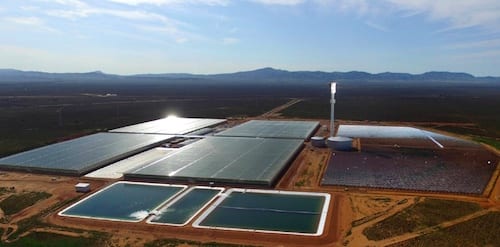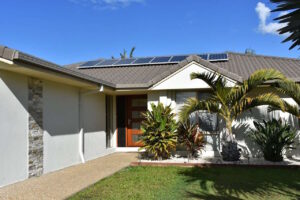Renewable energy production from Australian businesses has more than doubled over the last two years, and nearly half are making the switch to wind and/or solar to take control over their electricity bills and to help reduce emissions.
A new survey from the Climate Council says the massive shift to wind and solar is happening because electricity bills are soaring and wind and solar and storage offer an affordable and reliable solution.
In Australia, 46 per cent of businesses are looking to turn to wind and solar, many are looking for those technologies to provide the bulk of their power needs, and they are also looking at storage and electric vehicles.
“This report shows that the rising cost of energy is the number one concern for Australian businesses over the next decade,” says the Climate Council’s Greg Bourne, a former chair of the Australian Renewable Energy Agency.
“So it’s no surprise that a variety of businesses from bakeries to breweries, and tech agencies to chilli and chicken farms, are all turning to affordable renewable energy and storage solutions.
“These businesses are actively investing in renewable energy in a bid to cut costs and take control of their power bills, while also playing a crucial role in transitioning the nation away from ageing, polluting and unreliable fossil fuels.”
The role of corporations is expected to be one of the key factors in the future of large-scale and distributed renewable energy projects over the coming decade, particularly if the federal government fails to lift its emissions reduction targets for 2030.
Right now, the government is seeking to lock in a 26 per cent cut in electricity emissions from 2005 levels by 2030, through its National Energy Guarantee.
But most independent analysis say this target will be largely met by the renewable energy target by 2020 – meaning little incentive for further construction in the following 10 years.
That leaves only state-based targets such as Victoria, Queensland, and the Northern Territory, and the underlying push from households and businesses turning to renewables and storage to address their electricity bills.
A total of 46,000 Australian businesses have already installed solar energy, and this has mostly been in relatively small-scale rooftop arrays, although the pace of this uptake has accelerated dramatically in the last 12-18 months, as this graph below illustrates.
According to the Clean Energy Regulator, the amount of rooftop solar installed by businesses (arrays of up to 1MW) will increase five fold in 2018 to around 100MW.
The other more recent phenomenon is the decision by very large businesses and energy users to turn to large-scale wind and solar project to lower their bills in response to the doubling of electricity prices and soaring gas bills.
Some companies, such as Nectar Farms, have chosen to electrify their businesses so they can use cheaper wind energy and battery storage, rather than expensive gas.
Nectar Farms will build the country’s largest vegetable greenhouse, powered by wind and solar, on an old gold mine in Stawell in Victoria, as part of a $550 million project with Neoen and Tesla.
In South Australia, Sundrop Farms turned to solar towers and solar thermal to provide power, heat and desalinated water for their tomato growing operations (pictured top).
In Queensland, Sun Metals will soon become Australia’s first major refiner to go solar with the imminent opening of its 124MW solar farm, which will help underpin a $300 million expansion of the refinery by locking in low electricity costs.
Other major corporations that have signed contracts for large-scale solar or wind farms include Telstra, CUB, Westpac, Foster’s, ANZ, and CC Amatil. There are many others in the pipeline.
The Climate Council quoted a recent Baker & McKenzie survey of business intentions which shows that 40 per cent of its respondents are looking at renewables, and 40 per cent are also considering some form of storage.
Other key factors include changing business models to align with renewables and storage, and also preparing for the widely anticipated uptake of electric vehicles, and infrastructure such as charging networks.
One-third of businesses said they were considering using renewables as their main source of energy in the next 18 months – that’s a big development from businesses putting on small amounts of rooftop solar to support their “green messaging”.
A total of 138 global corporations have made a commitment to go ‘100% renewable’, including food producers, car manufacturers, data centre operators, breweries, real estate companies, banks and fashion brands .
These 100 per cent renewable companies include Microsoft, Apple, Google, Facebook, Wells Fargo, Johnson & Johnson and Amazon. They also include Anheuser-Busch, the owner of Australia’s Carlton & United Breweries, which is also going 100 per cent renewable.
In the US, nearly two-thirds of Fortune 100 and nearly half of Fortune 500 companies have set ambitious renewable or sustainability targets.
“This is a world-wide transition, with businesses around the globe taking advantage of the investment opportunities associated with renewable energy,” Bourne says.
Climate Council Energy and Climate Solutions Analyst Petra Stock said businesses were naturally transitioning to renewable energy and battery storage, with wind and solar now the cheapest forms of new-build energy generation, far cheaper than a new coal power station.
“This transition is good for the pockets of business owners and good for our climate, it really is a win-win.”
“This report showcases a range of Aussie businesses who are benefiting from making the switch to solar and wind, including eight New South Wales chicken farms that are saving an astonishing $2,000 a day,” said Stock.
“It simply makes good economic sense for businesses to make the switch to clean, affordable and reliable renewable energy and battery storage. Renewables are taking care of Aussie businesses facing high electricity prices.”












